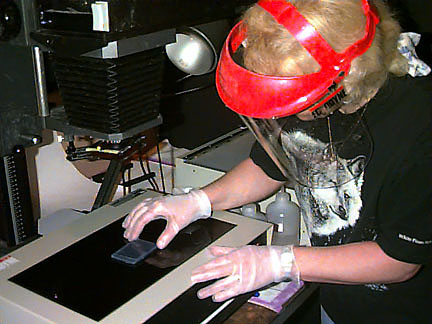![[titlebar]](../cyberlab.gif)
![[titlebar]](../cyberlab.gif)
After we have removed our gel from the running tank, we need to use ultraviolet light to visualize the DNA and verify that our Restriction Digest was successful. Does DNA fluoresce when exposed to UV light? Not on its own. Remember when we added dyes to our Blue-Juice to help us visualize the progress of the gel as it was running? We do something similar in this situation. Rather than "seeing" the DNA, we will be "seeing" a different molecule, called Ethidium Bromide (EtBr).
EtBr is an Intercalating Agent, meaning it wedges itself into the grooves of DNA and stays there. More base pairs mean more gooves, which in turn means more EtBr can insert itself. This is an important concept. EtBr also has the property of fluorescing under UV light. So if we soak our gel in a solution of EtBr, it will intercalate into the DNA, then if we place our gel on or under a UV source, we can "see" the DNA by actually detecting the fluorescence of the EtBr. Wherever there is DNA, we will see a bright band at that point in the gel. Which band do you think would be brighter, a 2 kb fragment or an equimolar amount of 20 kb DNA? Which has the most EtBr associated with it? The 20 kb fragment, right.

In the photo above, Margaret is preparing to examine our gel and see if everything turned out as expected. The box the gel is sitting on is called a UV Transilluminator, and the UV light shines up through the gel. That is why Margaret is wearing a UV-protective face shield. She is wearing gloves for at least three reasons:
![[bottle of EtBr]](fullsize/etbr.jpg) The latter has the advantages of not requiring a soaking period after running the gel, and being able to check the gel as it is running with a hand-held UV source.
The latter has the advantages of not requiring a soaking period after running the gel, and being able to check the gel as it is running with a hand-held UV source. ![[darkroom door]](fullsize/darkroom.jpg) The obvious disadvantage is that the gel and buffer have a carcinogen in them the entire time you're using them. If you are careful, there is really no cause for alarm, so either method is commonly used. The photo to the left shows a bottle of EtBr. It is always kept in light-sensitive bottles because of its photosensitivity, and concentrated stocks should be handled with caution.
The obvious disadvantage is that the gel and buffer have a carcinogen in them the entire time you're using them. If you are careful, there is really no cause for alarm, so either method is commonly used. The photo to the left shows a bottle of EtBr. It is always kept in light-sensitive bottles because of its photosensitivity, and concentrated stocks should be handled with caution.
If the gel shows bands after EtBr staining, a polaroid photograph is taken as a permanent record. After the photograph is taken, the gel is discarded in the biohazard waste, and the buffers are decontaminated and discarded. Notice the lighting source and camera apparatus connected to the UV Transilluminator in the photo above. Because this is photography (albeit limited) and lighting/darkness is important, this is usually done in a darkroom. Some facilities even have illuminated signs above the door displaying whether or not the room is in use, like in the photo to the right.